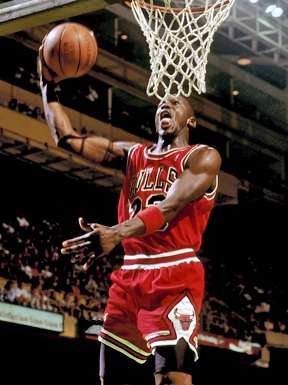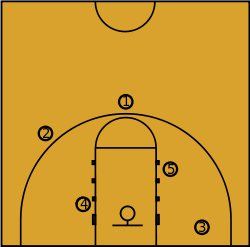Shooting guard
The shooting guard (SG), also known as the two, two guard or off guard,[1] is one of the five traditional positions in a regulated basketball game. A shooting guard's main objective is to score points for their team and steal the ball on defense.[1] Some teams ask their shooting guards to bring up the ball as well; these players are known colloquially as combo guards.[2] A player who can switch between playing shooting guard and small forward is known as a swingman.[3] In the NBA, shooting guards usually range from 6' 2" (1.88 m) to 6' 6" (1.98 m), and from 5' 8" (1.73 m) to 5' 11" (1.80 m) in the WNBA.

Characteristics and styles of play
The Basketball Handbook by Lee Rose describes a shooting guard as a player whose primary role is to score points. As the name suggests, most shooting guards are good long-range shooters, typically averaging 35–40 percent from three-point range. Many shooting guards are also strong and athletic, and have the ability to get inside the paint and drive to the basket.
Typically, shooting guards are taller than point guards. Height at the position varies; many bigger shooting guards also play small forward. Shooting guards should be good ball handlers and be able to pass reasonably well, though passing is not their main priority. Since good shooting guards may attract double-teams, they are frequently the team's back-up ball handlers to the point guard and typically get a fair number of assists.[4]
Shooting guards must be able to score in various ways, especially late in a close game when defenses are tighter. They need to have a good free throw percentage too, to be reliable in close games and to discourage opposing players from fouling. Because of the high level of offensive skills shooting guards need, they are often a team's primary scoring option, and sometimes the offense is built around them.
In the NBA, there are some shooting guards referred to as "3 and D" players. The term 3 and D implies that the player is a good 3 point shooter who can also play solid (sometimes elite) defense. The 3 and D player has become very important as the game sways to be perimeter oriented.[5]
Good shooting guards can often play point guard to a certain extent. It is usually accepted that point guards should have the ball in their hands at most times in the game, but sometimes the shooting guard has a significant enough influence on the team where he or she handles the ball extremely often, to the point where the point guard may be reduced to a backup ball handler or spot-up shooter.
Notable shooting guards
Notable NBA and WNBA shooting guards include some of the greatest players of all time, including Michael Jordan, Kobe Bryant, DeMar DeRozan, Jimmy Butler, Joe Johnson, Dwyane Wade, Manu Ginóbili, Allen Iverson, Cynthia Cooper, James Harden, Tracy McGrady, Ray Allen, Clyde Drexler, George Gervin, Reggie Miller, Diana Taurasi, Klay Thompson, Paul George, and Donovan Mitchell.
Notes
- Shooting guards are 6'3"–6'7". BBC Sports academy. URL last accessed 2006-09-09.
- Greg Haefner (October 18, 2008). "NBA Analysis: The Rise of the "Hybrid" Player". Bleacher Report. Retrieved May 13, 2020.
- "Basketball Swingman". Rookie Road. Retrieved May 13, 2020.
- "NBA.com - Players and Positions". Nba.com. Retrieved 3 February 2018.
- "'3-and-D': The specialist's path to a long NBA career". Usatoday.com. Retrieved 3 February 2018.
References
- The Basketball Handbook (pg 15) (2004). Lee H. Rose ISBN 0-7360-4906-1
External links
![]()
